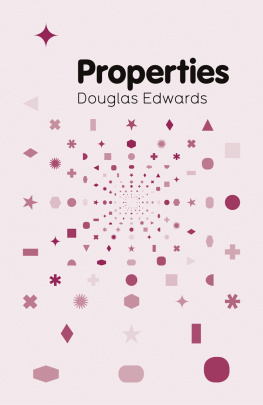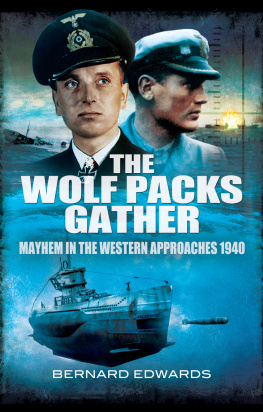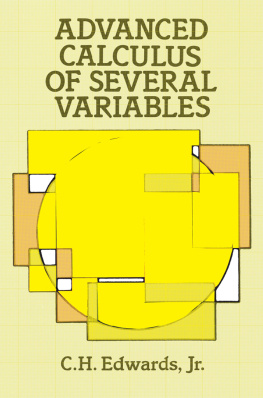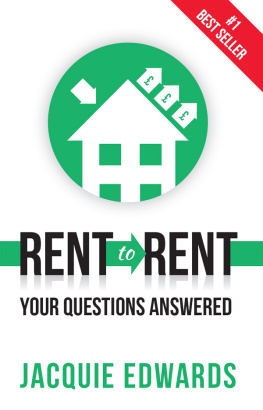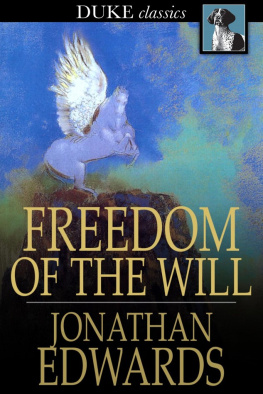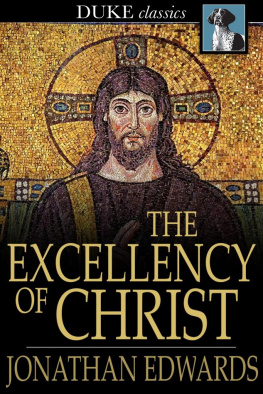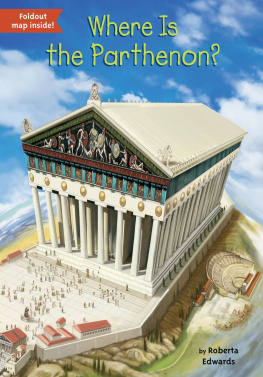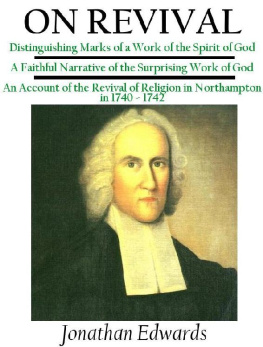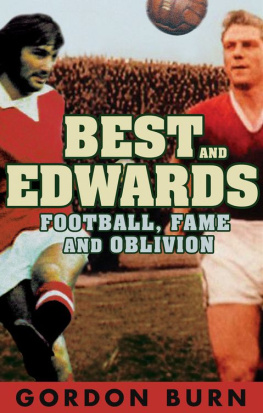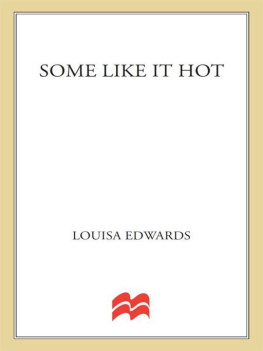Edwards - Properties
Here you can read online Edwards - Properties full text of the book (entire story) in english for free. Download pdf and epub, get meaning, cover and reviews about this ebook. City: Cambridge, year: 2014, publisher: Wiley;Polity, genre: Religion. Description of the work, (preface) as well as reviews are available. Best literature library LitArk.com created for fans of good reading and offers a wide selection of genres:
Romance novel
Science fiction
Adventure
Detective
Science
History
Home and family
Prose
Art
Politics
Computer
Non-fiction
Religion
Business
Children
Humor
Choose a favorite category and find really read worthwhile books. Enjoy immersion in the world of imagination, feel the emotions of the characters or learn something new for yourself, make an fascinating discovery.
Properties: summary, description and annotation
We offer to read an annotation, description, summary or preface (depends on what the author of the book "Properties" wrote himself). If you haven't found the necessary information about the book — write in the comments, we will try to find it.
Edwards: author's other books
Who wrote Properties? Find out the surname, the name of the author of the book and a list of all author's works by series.
Properties — read online for free the complete book (whole text) full work
Below is the text of the book, divided by pages. System saving the place of the last page read, allows you to conveniently read the book "Properties" online for free, without having to search again every time where you left off. Put a bookmark, and you can go to the page where you finished reading at any time.
Font size:
Interval:
Bookmark:

Table of Contents
Key Concepts in Philosophy Series

Copyright Douglas Edwards 2014
The right of Douglas Edwards to be identified as Author of this Work has been asserted in accordance with the UK Copyright, Designs and Patents Act 1988.
First published in 2014 by Polity Press
Polity Press
65 Bridge Street
Cambridge CB2 1UR, UK
Polity Press
350 Main Street
Malden, MA 02148, USA
All rights reserved. Except for the quotation of short passages for the purpose of criticism and review, no part of this publication may be reproduced, stored in a retrieval system, or transmitted, in any form or by any means, electronic, mechanical, photocopying, recording or otherwise, without the prior permission of the publisher.
ISBN-13: 978-0-7456-6174-2
ISBN-13: 978-0-7456-6175-9(pb)
ISBN-13: 978-0-7456-8410-9(epub)
ISBN-13: 978-0-7456-8409-3(mobi)
A catalogue record for this book is available from the British Library.
The publisher has used its best endeavours to ensure that the URLs for external websites referred to in this book are correct and active at the time of going to press. However, the publisher has no responsibility for the websites and can make no guarantee that a site will remain live or that the content is or will remain appropriate.
Every effort has been made to trace all copyright holders, but if any have been inadvertently overlooked the publisher will be pleased to include any necessary credits in any subsequent reprint or edition.
For further information on Polity, visit our website: www.politybooks.com
To Mum and Dad
Preface
The world is populated with many different objects: tables, chairs, roses, fire engines, blades of grass and human beings, to name just a few, each occupying its own special region of spacetime. When we distinguish between them, though, we often don't just make use of the idea that they exist in different locations; we also talk about the different features, attributes, or properties that they have. For instance, you and I have the property of being human, whereas tables and chairs do not. Roses and fire engines have the property of being red (or at least some do), whereas blades of grass do not. Conversely, the properties that objects have also help us to make sense of the ways in which distinct objects are similar: roses and fire engines are similar in an important way, as you and I are, because of the properties they and we share. However, positing the existence of properties immediately raises some interesting metaphysical questions. For example, how do we make sense of the idea that the redness of a fire engine is the same as the redness of a rose, when the fire engine and the rose exist in different places? Does this mean that one thing the property redness exists in different places at once, and, if so, how?
Understanding properties has been one of the main tasks of metaphysicians since the ancients, and a number of innovative proposals have been put forward. The aim of this book is to provide an accessible introduction to the main theories of properties: the view that properties are universals; the view that properties are constructed from tropes; and the view that properties are classes or sets of objects. We will chart these central positions in the debate and more, and we will note their strengths and weaknesses. We will address the main challenge to views that take properties seriously that posed by Quine which argues, contrary to what we said above, that we do not need properties to do any interesting explanatory work. We will address the question of what a theory of properties is intended to do, and we will take seriously the question of whether any single theory of properties is able to account for all the features that properties have been taken to have. We will also explore the connections between debates about properties and debates elsewhere in philosophy.
The first chapter introduces the topic under discussion and explores the main reasons for positing the existence of properties, including the one over many argument. It then raises the question of what the constraints on a theory of properties are by considering the various jobs properties have been taken to do, before making some terminological distinctions. The second chapter discusses perhaps the most well-known view of properties, namely the view that properties are universals, and assesses both the transcendental view, attributed to Plato and developed by Bertrand Russell, and the immanent view, attributed to Aristotle and developed recently by David Armstrong. The third chapter introduces and assesses the view that properties are to be accounted for in terms of tropes. The fourth chapter assesses Quine's scepticism about properties and addresses his challenge to the theories under discussion in this book, which states that there are no properties at all. The fifth chapter explores various forms of nominalism about properties, particularly predicate nominalism, concept nominalism, class nominalism, mereological nominalism and resemblance nominalism. These views are all varieties of nominalism, as they deny or at least claim to deny the existence of universals or tropes. The sixth chapter explores pluralist approaches to properties, in particular David Lewis's influential distinction between abundant and natural properties. Finally, the seventh chapter examines some of the roles properties have in other debates in philosophy and discusses how the different accounts of properties explored in previous chapters might be affected.
As will become clear as we go through the book, we will rarely come across knock-down arguments against a view. Instead, the pattern that will become familiar is that each view has its own benefits and its own costs. Accordingly, the evaluation of competing views often takes the form of a cost/benefit analysis, and the choice of the view to adopt may not be particularly clear-cut. This is especially so in the case of the views under discussion in are designed to rectify this matter somewhat by attempting to show that incorporating different aspects of the previously discussed views into a new conception of properties can yield some progress. Whether they ultimately succeed, however, is a matter for debate.
I have approached this book as one does a series of philosophy lectures, in that the aim is to give a good understanding of the topic and to leave the audience primed and ready to investigate the subject, and the texts discussed, in greater depth. To this end I have included further reading lists at the end of each chapter, in addition to references throughout the main text. Many of the key texts in twentieth-century work on properties that are discussed are collected in D. H. Mellor and Alex Oliver's edited volume Properties (Oxford University Press, 1997). To make it easier for those who are using that book to find references in the text, for all the quotations from works reprinted in it I have included apart from the page number of the original text a reference to the corresponding page number in Mellor and Oliver. In some cases where the location of the original articles is hard to come by, I only have used the references to page numbers in the reprinted versions in the Mellor and Oliver volume, but included the full references in the bibliography.
Next pageFont size:
Interval:
Bookmark:
Similar books «Properties»
Look at similar books to Properties. We have selected literature similar in name and meaning in the hope of providing readers with more options to find new, interesting, not yet read works.
Discussion, reviews of the book Properties and just readers' own opinions. Leave your comments, write what you think about the work, its meaning or the main characters. Specify what exactly you liked and what you didn't like, and why you think so.

